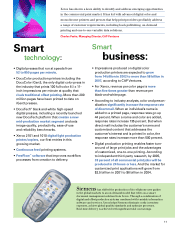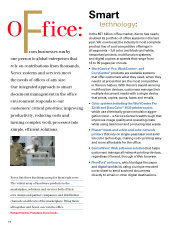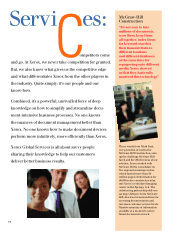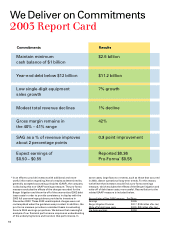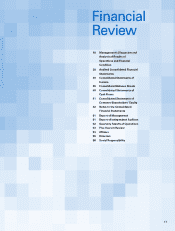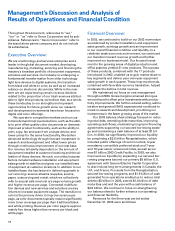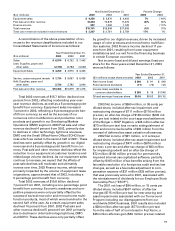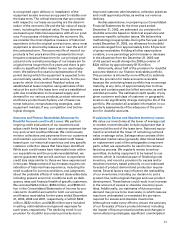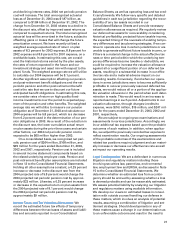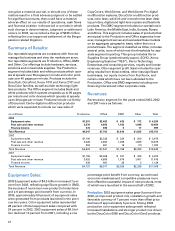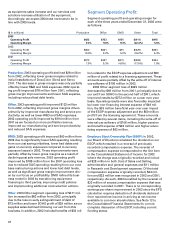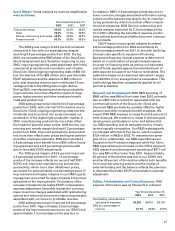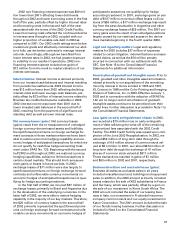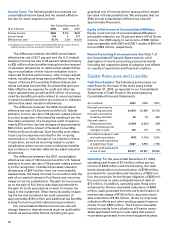Xerox 2003 Annual Report Download - page 23
Download and view the complete annual report
Please find page 23 of the 2003 Xerox annual report below. You can navigate through the pages in the report by either clicking on the pages listed below, or by using the keyword search tool below to find specific information within the annual report.
21
is recognized upon delivery or installation of the
equipment as sale revenue as opposed to ratably over
the lease term. The critical elements that we consider
with respect to our lease accounting are the determi-
nation of the economic life and the fair value of equip-
ment, including the residual value. Those elements
are based upon historical experience with all our prod-
ucts. For purposes of determining the economic life,
we consider the most objective measure of historical
experience to be the original contract term, since most
equipment is returned by lessees at or near the end of
the contracted term. The economic life of most of our
products is five years since this represents the most
frequent contractual lease term for our principal prod-
ucts and only a small percentage of our leases are for
original terms longer than five years and there is gen-
erally no significant after-market for our used equip-
ment. We believe five years is representative of the
period during which the equipment is expected to be
economically usable, with normal service, for the pur-
pose for which it is intended. Residual values are
established at lease inception using estimates of fair
value at the end of the lease term and are established
with due consideration to forecasted supply and
demand for our various products, product retirement
and future product launch plans, end of lease cus-
tomer behavior, remanufacturing strategies, used
equipment markets, if any, competition and techno-
logical changes.
Accounts and Finance Receivables Allowance for
Doubtful Accounts and Credit Losses: We perform
ongoing credit evaluations of our customers and
adjust credit limits based upon customer payment his-
tory and current creditworthiness. We continuously
monitor collections and payments from our customers
and maintain a provision for estimated credit losses
based upon our historical experience and any specific
customer collection issues that have been identified.
While such credit losses have historically been within
our expectations and the provisions established, we
cannot guarantee that we will continue to experience
credit loss rates similar to those we have experienced
in the past. Measurement of such losses requires con-
sideration of historical loss experience, including the
need to adjust for current conditions, and judgments
about the probable effects of relevant observable data,
including present economic conditions such as delin-
quency rates and financial health of specific customers.
We recorded $224 million, $353 million, and $506 mil-
lion in the Consolidated Statements of Income for pro-
visions for doubtful accounts for both our accounts
and finance receivables for the years ended December
31, 2003, 2002 and 2001, respectively, of which $224
million, $332 million, and $438 million were included
in selling, administrative and general expenses for
such years, respectively. The declining trend in our
provision for doubtful accounts is primarily due to
improved customer administration, collection practices
and credit approval policies, as well as our revenue
declines.
As discussed above, in preparing our Consolidated
Financial Statements for the three years ended
December 31, 2003, we estimated our provision for
doubtful accounts based on historical experience and
customer-specific collection issues. We believe this
methodology is appropriate. During the five year period
ended December 31, 2003, our allowance for doubtful
accounts ranged from approximately 3.4 to 5.5 percent
of gross receivables. Holding all other assumptions
constant, a one percentage point increase or decrease
in the allowance from the December 31, 2003 rate
of 4.6 percent would change the 2003 provision of
$224 million by approximately $115 million.
Historically, about half of the provision for doubtful
accounts relates to our finance receivables portfolio.
This provision is inherently more difficult to estimate
than the provision for trade accounts receivable
because the underlying lease portfolio has an average
maturity, at any time, of approximately two to three
years and contains past due billed amounts, as well as
unbilled amounts. The estimated credit quality of any
given customer and class of customer or geographic
location can significantly change during the life of the
portfolio. We consider all available information in our
quarterly assessments of the adequacy of the provi-
sion for doubtful accounts.
Provisions for Excess and Obsolete Inventory Losses:
We value our inventories at the lower of average cost
or market. Inventories also include equipment that is
returned at the end of the lease term. Returned equip-
ment is recorded at the lower of remaining net book
value or salvage value. Salvage value consists of the
estimated market value (generally determined based
on replacement cost) of the salvageable component
parts, which are expected to be used in the remanu-
facturing process. We regularly review inventory
quantities, including equipment to be leased to cus-
tomers, which is included as part of finished goods
inventory, and record a provision for excess and/or
obsolete inventory based primarily on our estimated
forecast of product demand and production require-
ments. Several factors may influence the realizability
of our inventories, including our decision to exit a
product line, technological changes and new product
development. These factors could result in an increase
in the amount of excess or obsolete inventory quan-
tities. Additionally, our estimates of future product
demand may prove to be inaccurate, in which case we
may have understated or overstated the provision
required for excess and obsolete inventories.
Although we make every effort to ensure the accuracy
of our forecasts of future product demand, including
the impact of future product launches and changes in
remanufacturing strategies, significant unanticipated


